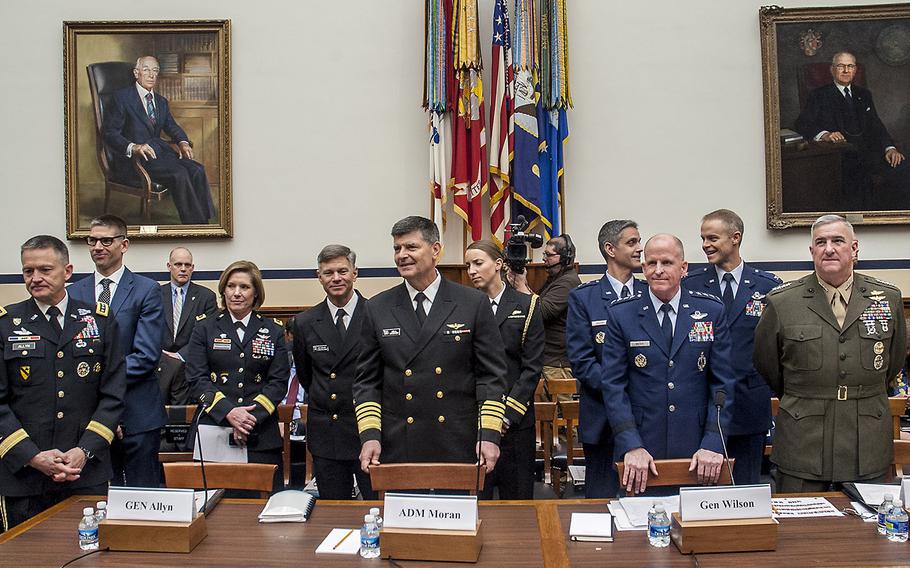
From left: Vice Chief of Staff of the Army Gen. Daniel B. Allyn, Vice Chief of Naval Operations Adm. William F. Moran, Vice Chief of Staff of the Air Force Gen. Stephen W. Wilson and Assistant Commandant of the Marine Corps Gen. Glenn M. Walters prepare to testify before the House Armed Services Committee, Feb. 7, 2017, on Capitol Hill. (Carlos Bongioanni/Stars and Stripes)
WASHINGTON — The chairman of the House Armed Services Committee said Tuesday that a new Congress and president could begin repairing the military this year as uniformed leaders again painted a grim picture of depleted forces.
Rep. Mac Thornberry, R-Texas, pointed to Congress’ defense spending caps and its inability to pass timely budgets, and vice chiefs of the Army, Navy, Marine Corps and Air Force backed that view in testimony, saying forces are stretched far too thin and hamstrung by the uncertainty of funding.
Only three out of 58 of the Army’s brigade combat teams are ready to “fight tonight,” and 53 percent of Navy aircraft are not ready to fly today, according to the testimony.
The Air Force and Marine Corps also described shrinking, ill-maintained and less ready forces.
The Armed Services Committee under Thornberry is embarking on another effort this year to boost military funding, and President Donald Trump has made a defense buildup a priority. The Pentagon gave Congress an informal proposal Tuesday to boost this year’s defense spending by $30 billion for aircraft, armored vehicles and training, according to the Associated Press.
But the defense caps are set to hold down defense spending again this year and partisan divisions on Capitol Hill are likely to make a solution difficult.
“I continue to be concerned — and sometimes even disturbed — by evidence that is accumulating on the damage inflicted upon our military in recent years and the stresses on the force,” Thornberry said. “But now with a new administration and a new Congress, we have the opportunity to begin the repairs.”
Democrats on the Armed Services Committee, which plays a key role in crafting the defense budget, joined the call to lift caps on defense that are often called sequestration.
Rep. Jim Cooper, D-Tenn., told the military leaders who testified Tuesday that the limits on funding the military are one of the biggest threats to U.S. security.
“Another way to put this is, the worst enemy we face is ourselves,” Cooper said. “The problem is not yours, it is ours. We should solve this sequestration problem.”
In the Pentagon's informal proposal to Congress, the Army is seeking $8.2 billion to keep troop numbers and buy helicopters; the Air Force wants $6.2 billion for more F-35 Joint Strike Fighters and airmen; the Navy wants $12 billion for ships, aircraft and missiles; and the Marine Corps is seeking $4.2 billion to pay for new weapons, according to the AP.
Thornberry told reporters Tuesday he had not seen the proposal yet. The Trump administration is expected to make a formal request for supplemental defense spending in March and will later send a full annual budget request to Congress.
The caps on spending are set to hold the base defense budget for 2018 at $549 billion, but Thornberry and his counterpart on the Senate Armed Services Committee, Sen. John McCain, R-Ariz., have proposed a $640 billion base budget.
The caps were passed as part of the Budget Control Act in 2011 and were designed to reduce federal spending at the urging of Republican fiscal hawks, but have since become widely criticized.
A voting bloc of House Republicans called the Freedom Caucus has supported the caps -- which also affect domestic federal spending -- and is seen as the main roadblock to getting repeal passed.
“All members of this committee should be asking [House] leadership why we cannot repeal the BCA. … Now is the time to take action on this and any delay is inexcusable,” Cooper said.
The military brass has spent the past two years warning about readiness. But Congress has been unable to repeal the caps and has continued to pass temporary budgets that throw a wrench into Pentagon planning.
Gen. Daniel Allyn, Army vice chief of staff of the Army, said the service is “outranged, outgunned, outdated” and -- under budget caps this year -- will have to reduce its size, putting the lives and safety of soldiers at risk.
“The most important actions you can take — steps that will have both positive and lasting impact – will be to immediately repeal the 2011 Budget Control Act,” Allyn said in prepared testimony.
The Air Force has shrunk to its smallest size and now faces a shortage of 1,555 pilots — 723 of those are fighter pilots — and 3,400 maintainers, said Gen. Stephen Wilson, the service’s vice chief of staff.
Congress authorized some increases in its annual National Defense Authorization Act, which was passed in December, but reversing the shortage could take years, Wilson said.
“The way out of this starts with manpower,” he said. “We think it will take six to eight years to bring our readiness back to where it needs to be.”tritten.travis@stripes.com Twitter: @Travis_Tritten